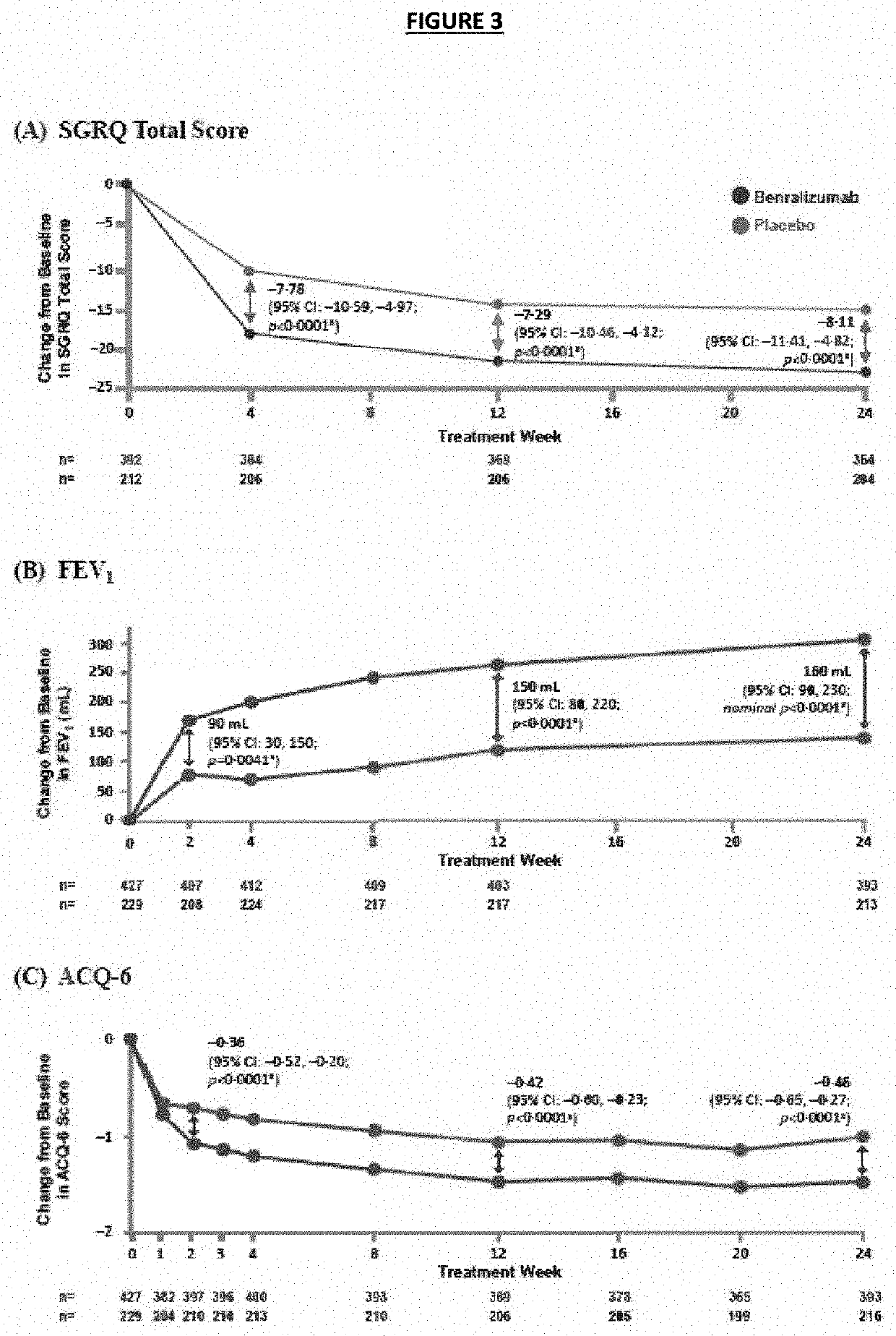Methods for treating severe asthma in patients with nasal polyposis
a technology for asthma and patients with nasal polyposis, which is applied in the direction of antibody medical ingredients, drug compositions, peptides, etc., can solve the problems of poor access to routine quality healthcare, high cost of health care, and difficult management of patients, so as to reduce the annual exacerbation rate of asthma
- Summary
- Abstract
- Description
- Claims
- Application Information
AI Technical Summary
Benefits of technology
Problems solved by technology
Method used
Image
Examples
example 1
and Methods
Subjects
[0064]Subjects in this study were required to be 18 to 75 years of age weighing at least 40 kg. They also must have had a physician diagnosis of asthma for a minimum of 12 months prior to screening as well as physician prescribed daily use of medium-dose or high-dose inhaled corticosteroids (ICS) plus another asthma controller (e.g., long-acting β2 agonists (LABA), long-acting muscarinic antagonists (LAMA), leukotriene receptor antagonists, methylxanthines, or OCS) for at least 12 months prior to screening. Medium and high-doses of ICS as defined in this study are shown in Table 1 below.
TABLE 1Estimated Comparative Daily Dosages for Inhaled CorticosteroidsMedium DailyHigh DailyDrugDose (Adult)Dose (Adult)Beclamethazone HFA / MDI>240-480μg>480μg40 or 801 μg / puffBudesonide DPI>600-1,200μg>1,200μg90, 180, or 200 μg / inhalationCiclesonide HFA / MDI>160-320μg>320-1280μg80 or 160 μg / inhalationFlunisolide CFC / MDI>1,000-2,000μg>2,000μg250 μg / puffFlunisolide HFA / MDI>320-640μg>6...
example 2
Enrollment and Baseline Characteristics
[0094]The baseline characteristics of all randomized subjects are provided in Table 2 below. Demographics and baseline clinical characteristics were similar between both treatment groups, and the study population was representative of a patient population with severe, eosinophilic asthma (Table 2). The majority of patients were white (85.9%) and female (60.8%). The mean age was 52.8 years, and mean BMI was 29.94 kg / m2. All patients reported exacerbations over the previous 12 months, with approximately half of the patients in each group (51.8% of benralizumab and 50.7% of placebo patients) experiencing 3 or more exacerbations. Lung function at screening, mean SGRQ total score, and mean ACQ-6 were also similar between groups. Mean PSIA severity scores at baseline for each of the top 3 ranked and for the average of the top 3 ranked impairments / symptoms were similar for both treatment groups.
[0095]Approximately 30% of patients in each group had BEC...
example 3
[0111]A post-hoc subanalysis of the previous study from Examples 1 and 2 was conducted to assess comprehensive response to benralizumab based on SNOT-22 and asthma measures. Patients with severe, eosinophilic asthma and a history of physician-diagnosed NP of any severity ongoing at baseline in Examples 1 and 2 were included in the post-hoc subgroup analysis to assess comprehensive response to benralizumab. Comprehensive response was defined as achieving a clinically meaningful improvement in SNOT-22 of −8.9 units and 4 additional criteria: 0 exacerbations, change from baseline to end of treatment (Week 24) in SGRQ total score of ≤−4 units, FEV1 improvement of ≥200 mL, change from baseline to week 24 in ACQ-6 total score of ≤−0.5.
[0112]The baseline demographics of all subjects are provided in Table 3 below. Some differences were seen at baseline between treatment groups in asthma measures (i.e., exacerbation history, SGRQ, and FEV1), but these differences were not statistically signi...
PUM
| Property | Measurement | Unit |
|---|---|---|
| time | aaaaa | aaaaa |
| forced expiratory volume | aaaaa | aaaaa |
| forced expiratory volume in 1 second | aaaaa | aaaaa |
Abstract
Description
Claims
Application Information
 Login to View More
Login to View More - R&D
- Intellectual Property
- Life Sciences
- Materials
- Tech Scout
- Unparalleled Data Quality
- Higher Quality Content
- 60% Fewer Hallucinations
Browse by: Latest US Patents, China's latest patents, Technical Efficacy Thesaurus, Application Domain, Technology Topic, Popular Technical Reports.
© 2025 PatSnap. All rights reserved.Legal|Privacy policy|Modern Slavery Act Transparency Statement|Sitemap|About US| Contact US: help@patsnap.com



